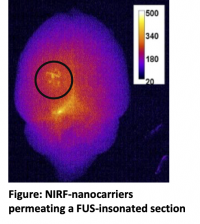STING agonist sonic propulsion for immunotherapy of paediatric gliomas
Primary supervisor: Maya Thanou, King’s College London
Secondary supervisor: Darren Hargrave, UCL
Additional supervisors: Antonios Pouliopoulos, James Arnold, King’s College London
Project
Project background and description:
There is currently no effective treatment for paediatric diffuse gliomas. Despite the development of novel pharmacological interventions, treatment outcomes remain poor and median survival after diagnosis is only 9 months. Numerous studies of systemic chemotherapy have all failed to demonstrate any significant improvement in survival. This failure is, in part, due to the blood-brain barrier, preventing therapeutic concentrations of drug from penetrating the tumour. It is therefore difficult to ensure that chemotherapeutic substances enter DMGs in sufficient concentrations. STING agonists for the cGAS/STING pathway have been suggested for brain tumours however penetration may be seriously limited.
Multiple approaches have been tested in an effort to increase delivered doses into brain tumours. Most notably, convection-enhanced delivery technique has shown promise in overcoming this failure, by increasing concentrations of chemotherapeutic substances entering DMGs. However, most approaches are either invasive or non-targeted. The only method that allows both non-invasive and targeted drug delivery into the brain is the combined used of focused ultrasound (FUS) and microbubbles. Ultrasound forces the systemically administered microbubbles into oscillations, which mechanically disrupt the BTB and allow passage of therapeutic molecules.
This project supplements our previously awarded project from the team. In this current project we aim to modulate the BTB and improve biological therapies’ permeation in “hard-to-treat” tumours such as paediatric gliomas. We will investigate if applied focused ultrasound and novel phase change nanodroplets (PCND) are efficient tools to improve penetration across the BTB and within the brain tumour. Further, we will introduce cGAMP molecules in the “shell” of the PCND that would be propelled in the brain tumour upon FUS activation. Perfluorocarbon core lipidic droplets respond to ultrasound by gas evolution turning to bubbles and they are currently in development due to their biological stability advantages. When turned to bubbles they cavitate and affect the permeability of the BTB to allow the propulsion of the therapeutics into the tumours. To monitor these phenomena, PCND cGAMP will be tagged, allowing their tracking to be followed by NIRF preclinical imaging. We will introduce cGAMP on the PCND using chemical coupling to lipids that will be part of the PCND shell. The PCND platform can accommodate a combination of therapeutics as part of their lipidic layer.
Key objectives are:
- Formulate and characterise novel labelled PCND, to accommodate cGAMP. cGAMP will be introduced using the layer-by-layer technique developed in our laboratories. The PCND will be characterised chemically for cGAMP content and physically for their size properties acoustic vaporisation and cavitation. These will be labelled using previously developed XLA750-NIRF/Rhodamine lipid conjugates (Y1)
- Label cGAMP with near infra-red fluorescence (NIRF) for image tracking in vivo. C57BL/6 mice will be used to develop tumours in the brain in pHGG models. Imaging will be used to monitor distribution of PCND and the STING agonists in tumours (Y1-2).
- Investigate the effect of focused ultrasound on cGAMP PCND bio-distribution in the murine model (in vivo) using imaging and tissue analysis. (Y2-3)
- Combine derived data from modelling and in vivo bio-distribution data to design the focused ultrasound application protocol. Analyse the effects of PCND mediated delivery across BTB (Y3).
- Assess the ability of focused ultrasound, in combination with labelled cGAMP PCND to stop tumour growth in the murine pHGG models. Excised tumours will be analysed to offer an inside of the effect of STING agonists on tumour markers and inflammatory macrophages, neutrophils, and NK cells as well as inflammatory cytokines (Y4).

Candidate background
The PhD candidate will need to have knowledge of chemistry to develop the biotherapeutics, and good understanding of physics of the ultrasound.
Potential Research Placements
- James Arnold, School of Cancer & Pharmaceutical Science, King’s College London
- Darren Hargrave, UCL Institute of Child Health
- Antonios Pouliopoulos, Department of Surgical & Interventional Engineering, King’s College London
References
- Englander, Z.K., Wei, HJ., Pouliopoulos, A.N. et al. Focused ultrasound mediated blood-brain barrier opening is safe and feasible in a murine pontine glioma model. Sci Rep 11, 6521 (2021). doi.org/10.1038/s41598-021-85180-y
- Cressey P, Amrahli M, So PW, Gedroyc W, Wright M, Thanou M. Image-guided thermosensitive liposomes for focused ultrasound enhanced co-delivery of carboplatin and SN-38 against triple negative breast cancer in mice. Biomaterials. 2021 Apr;271:120758. doi: 10.1016/j.biomaterials.2021.120758.
- Hargrave D. Pediatric diffuse intrinsic pontine glioma: can optimism replace pessimism? CNS Oncol. 2012 Nov;1(2):137-48. doi: 10.2217/cns.12.15.
- Szychot E, Walker D, Collins P, Hyare H, Shankar A, Bienemann A, Hollingworth M, Gill S. Clinical experience of convection-enhanced delivery (CED) of carboplatin and sodium valproate into the pons for the treatment of diffuse intrinsic pontine glioma (DIPG) in children and young adults after radiotherapy. Int J Clin Oncol. 2021 Apr;26(4):647-658. doi: 10.1007/s10147-020-01853-0.
- Bernstock JD, Hoffman SE, Kappel AD, Valdes PA, Essayed W, Klinger NV, Kang KD, Totsch SK, Olsen HE, Schlappi CW, Filipski K, Gessler FA, Baird L, Filbin MG, Hashizume R, Becher OJ, Friedman GK. Immunotherapy approaches for the treatment of diffuse midline gliomas. Oncoimmunology. 2022 Sep 26;11(1):2124058. doi: 10.1080/2162402X.2022.2124058. PMID: 36185807; PMCID: PMC9519005.
